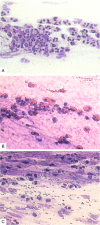Chronic Rhinosinusitis: T2r38 Genotyping and Nasal Cytology in Primary Ciliary Dyskinesia
- PMID: 35312075
- PMCID: PMC10078746
- DOI: 10.1002/lary.30112
Chronic Rhinosinusitis: T2r38 Genotyping and Nasal Cytology in Primary Ciliary Dyskinesia
Abstract
Objectives: Chronic rhinosinusitis (CRS) is a major hallmark of primary ciliary dyskinesia (PCD). We investigated the possible correlation between some severity markers of CRS and several clinical features of the disease. We further studied the bitter taste receptor TAS2R38 polymorphisms to identify the genotypes associated with more severe disease.
Methods: We included 39 adult PCD patients with (CRSwNP) and without nasal polyposis (CRSsNP); a sample for nasal cytology was obtained and clinical cytological grading (CCG) was determined. The SNOT-22 and Lund-Mackay scores were recorded. A sample of DNA was extracted from peripheral blood to investigate TAS2R38 polymorphisms.
Results: CRSwNP patients had features of more severe disease: indeed, they had statistically significantly higher frequency of previous sinus surgery, higher SNOT-22, LM scores, and CCG than CRSsNP patients. Upon genotyping of TAS2R38 polymorphisms, we observed that the AVI-AVI genotype, associated to homozygous nonfunctional bitter TAS2R38 receptor, was more prevalent among CRSwNP (100%) than in CRSsNP patients (0%); furthermore, AVI-AVI subjects showed statistically significantly worse SNOT-22 and CCG scores than PAV-PAV and PAV-AVI subjects. The group of AVI-AVI patients also had more frequent respiratory exacerbations, Gram-negative infections, and Pseudomonas aeruginosa colonization than PAV-PAV and PAV-AVI patients.
Conclusion: Our findings indicate for the first time that PCD patients with CRSwNP display a more severe disease than those with CRSsNP. Genotyping of TAS2R38 polymorphisms demonstrated that in PCD patients, the AVI-AVI genotype is strikingly more prevalent among CRSwNP than in CRSsNP, while the PAV-PAV genotype might be protective against Gram-negative infections and respiratory exacerbations.
Level of evidence: 3 Laryngoscope, 133:248-254, 2023.
Keywords: TAS2R38; bitter taste receptors; chronic rhinosinusitis; nasal cytology; primary ciliary dyskinesia.
© 2022 The Authors. The Laryngoscope published by Wiley Periodicals LLC on behalf of The American Laryngological, Rhinological and Otological Society, Inc.
Figures


Similar articles
-
Primary Ciliary Dyskinesia: The Impact of Taste Receptor (TAS2R38) Gene Polymorphisms on Disease Outcome and Severity.Int Arch Allergy Immunol. 2020;181(9):727-731. doi: 10.1159/000508938. Epub 2020 Jul 13. Int Arch Allergy Immunol. 2020. PMID: 32659773
-
The role of TAS2R38 genotype in surgical outcomes and culturable bacteria in chronic rhinosinusitis with or without nasal polyps.Rhinology. 2023 Feb 1;61(1):54-60. doi: 10.4193/Rhin22.118. Rhinology. 2023. PMID: 36278985
-
In Vivo Biofilm Formation, Gram-Negative Infections and TAS2R38 Polymorphisms in CRSw NP Patients.Laryngoscope. 2018 Oct;128(10):E339-E345. doi: 10.1002/lary.27175. Epub 2018 Mar 23. Laryngoscope. 2018. PMID: 29570813
-
Taste receptors in chronic rhinosinusitus, what is the evidence? A systematic review.Int Forum Allergy Rhinol. 2022 Jul;12(7):917-934. doi: 10.1002/alr.22938. Epub 2022 Jan 5. Int Forum Allergy Rhinol. 2022. PMID: 34913601 Free PMC article.
-
The emerging role of the bitter taste receptor T2R38 in upper respiratory infection and chronic rhinosinusitis.Am J Rhinol Allergy. 2013 Jul-Aug;27(4):283-6. doi: 10.2500/ajra.2013.27.3911. Am J Rhinol Allergy. 2013. PMID: 23883809 Review.
Cited by
-
Functional Alteration and Differential Expression of the Bitter Taste Receptor T2R38 in Human Paranasal Sinus in Patients with Chronic Rhinosinusitis.Int J Mol Sci. 2023 Feb 24;24(5):4499. doi: 10.3390/ijms24054499. Int J Mol Sci. 2023. PMID: 36901926 Free PMC article.
-
TAS2R38 Bitter Taste Receptor Polymorphisms in Patients with Chronic Rhinosinusitis with Nasal Polyps Preliminary Data in Polish Population.Biomedicines. 2024 Jan 12;12(1):168. doi: 10.3390/biomedicines12010168. Biomedicines. 2024. PMID: 38255273 Free PMC article.
-
Clinical Associations of Bitter Taste Perception and Bitter Taste Receptor Variants and the Potential for Personalized Healthcare.Pharmgenomics Pers Med. 2023 Feb 12;16:121-132. doi: 10.2147/PGPM.S390201. eCollection 2023. Pharmgenomics Pers Med. 2023. PMID: 36819962 Free PMC article.
-
The impact of the bitter taste receptor on the predisposition to chronic rhinosinusitis.Acta Otorhinolaryngol Ital. 2025 Apr;45(2):116-123. doi: 10.14639/0392-100X-N3032. Acta Otorhinolaryngol Ital. 2025. PMID: 40353482 Free PMC article.
-
Sinonasal disease among patients with primary ciliary dyskinesia: an international study.ERJ Open Res. 2023 May 22;9(3):00701-2022. doi: 10.1183/23120541.00701-2022. eCollection 2023 May. ERJ Open Res. 2023. PMID: 37228283 Free PMC article.
References
-
- Yoo F, Schlosser RJ, Storck KA, Ganjaei KG, Rowan NR, Soler ZM. Effects of endoscopic sinus surgery on objective and subjective measures of cognitive dysfunction in chronic rhinosinusitis. Int Forum Allergy Rhinol 2019;9(10):1135–1143. - PubMed
-
- Pifferi M, Bush A, Rizzo M, et al. Olfactory dysfunction is worse in primary ciliary dyskinesia compared with other causes of chronic sinusitis in children. Thorax 2018;73(10):980–982. - PubMed
-
- Alanin MC, Johansen HK, Aanaes K, et al. Simultaneous sinus and lung infections in patients with primary ciliary dyskinesia. Acta Otolaryngol 2015;135:58–63. - PubMed
MeSH terms
Substances
LinkOut - more resources
Full Text Sources
Medical
Research Materials

